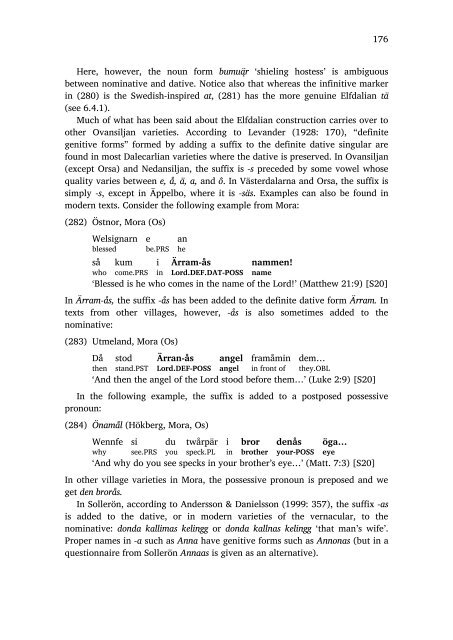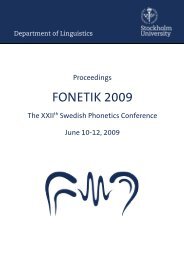Grammaticalization in the North: Noun Phrase Morphosyntax in ...
Grammaticalization in the North: Noun Phrase Morphosyntax in ...
Grammaticalization in the North: Noun Phrase Morphosyntax in ...
Create successful ePaper yourself
Turn your PDF publications into a flip-book with our unique Google optimized e-Paper software.
176<br />
Here, however, <strong>the</strong> noun form bumuä ̨r ‗shiel<strong>in</strong>g hostess‘ is ambiguous<br />
between nom<strong>in</strong>ative and dative. Notice also that whereas <strong>the</strong> <strong>in</strong>f<strong>in</strong>itive marker<br />
<strong>in</strong> (280) is <strong>the</strong> Swedish-<strong>in</strong>spired at, (281) has <strong>the</strong> more genu<strong>in</strong>e Elfdalian tä<br />
(see 6.4.1).<br />
Much of what has been said about <strong>the</strong> Elfdalian construction carries over to<br />
o<strong>the</strong>r Ovansiljan varieties. Accord<strong>in</strong>g to Levander (1928: 170), ―def<strong>in</strong>ite<br />
genitive forms‖ formed by add<strong>in</strong>g a suffix to <strong>the</strong> def<strong>in</strong>ite dative s<strong>in</strong>gular are<br />
found <strong>in</strong> most Dalecarlian varieties where <strong>the</strong> dative is preserved. In Ovansiljan<br />
(except Orsa) and Nedansiljan, <strong>the</strong> suffix is -s preceded by some vowel whose<br />
quality varies between e, å, ä, a, and ô. In Västerdalarna and Orsa, <strong>the</strong> suffix is<br />
simply -s, except <strong>in</strong> Äppelbo, where it is -säs. Examples can also be found <strong>in</strong><br />
modern texts. Consider <strong>the</strong> follow<strong>in</strong>g example from Mora:<br />
(282) Östnor, Mora (Os)<br />
Welsignarn e<br />
an<br />
blessed be.PRS he<br />
så kum i Ärram-ås nammen!<br />
who come.PRS <strong>in</strong> Lord.DEF.DAT-POSS name<br />
‗Blessed is he who comes <strong>in</strong> <strong>the</strong> name of <strong>the</strong> Lord!‘ (Mat<strong>the</strong>w 21:9) [S20]<br />
In Ärram-ås, <strong>the</strong> suffix -ås has been added to <strong>the</strong> def<strong>in</strong>ite dative form Ärram. In<br />
texts from o<strong>the</strong>r villages, however, -ås is also sometimes added to <strong>the</strong><br />
nom<strong>in</strong>ative:<br />
(283) Utmeland, Mora (Os)<br />
Då stod Ärran-ås angel framåm<strong>in</strong> dem…<br />
<strong>the</strong>n stand.PST Lord.DEF-POSS angel <strong>in</strong> front of <strong>the</strong>y.OBL<br />
‗And <strong>the</strong>n <strong>the</strong> angel of <strong>the</strong> Lord stood before <strong>the</strong>m…‘ (Luke 2:9) [S20]<br />
In <strong>the</strong> follow<strong>in</strong>g example, <strong>the</strong> suffix is added to a postposed possessive<br />
pronoun:<br />
(284) Önamål (Hökberg, Mora, Os)<br />
Wennfe si du twårpär i bror denås öga…<br />
why see.PRS you speck.PL <strong>in</strong> bro<strong>the</strong>r your-POSS eye<br />
‗And why do you see specks <strong>in</strong> your bro<strong>the</strong>r‘s eye…‘ (Matt. 7:3) [S20]<br />
In o<strong>the</strong>r village varieties <strong>in</strong> Mora, <strong>the</strong> possessive pronoun is preposed and we<br />
get den brorås.<br />
In Sollerön, accord<strong>in</strong>g to Andersson & Danielsson (1999: 357), <strong>the</strong> suffix -as<br />
is added to <strong>the</strong> dative, or <strong>in</strong> modern varieties of <strong>the</strong> vernacular, to <strong>the</strong><br />
nom<strong>in</strong>ative: donda kallimas kel<strong>in</strong>gg or donda kallnas kel<strong>in</strong>gg ‗that man‘s wife‘.<br />
Proper names <strong>in</strong> -a such as Anna have genitive forms such as Annonas (but <strong>in</strong> a<br />
questionnaire from Sollerön Annaas is given as an alternative).

















